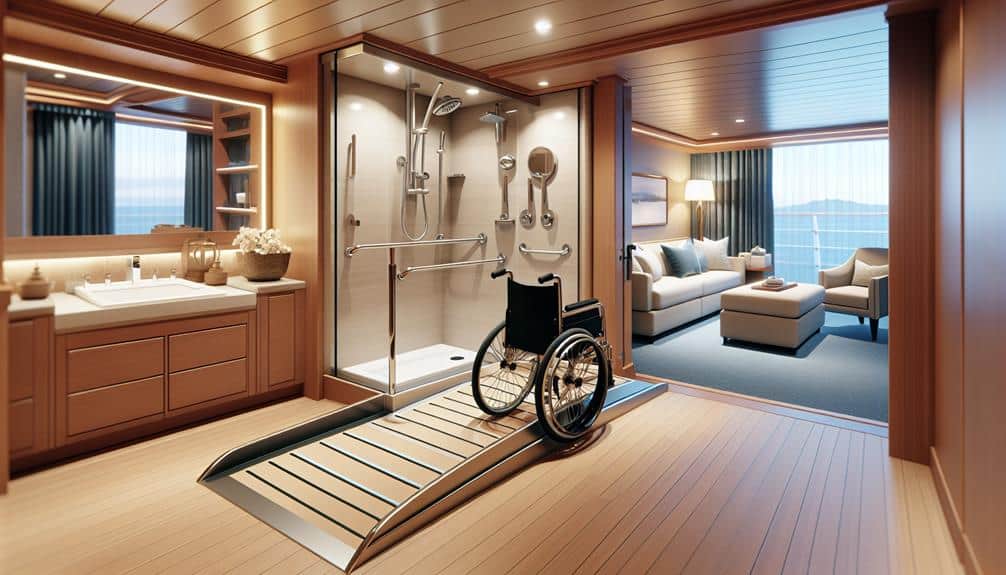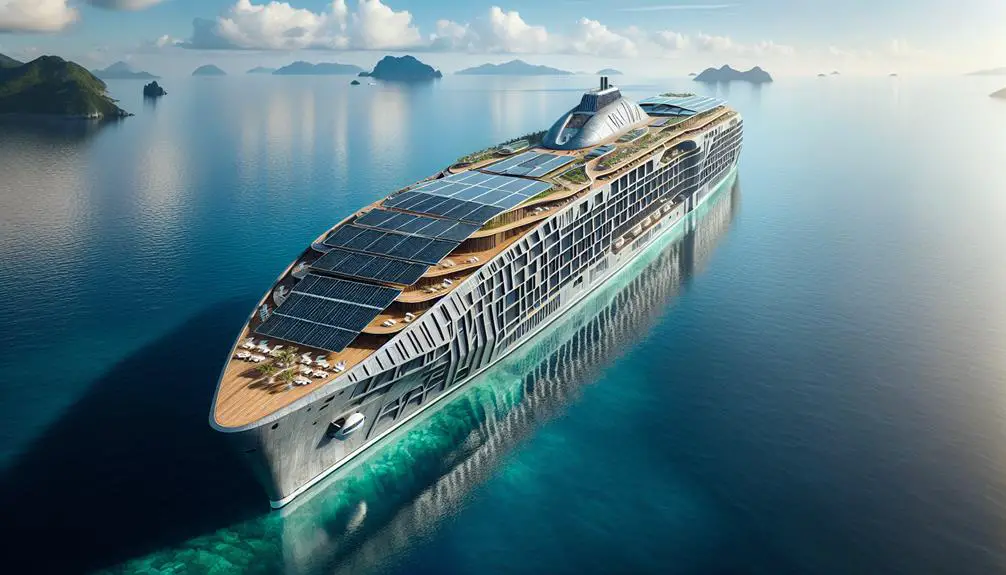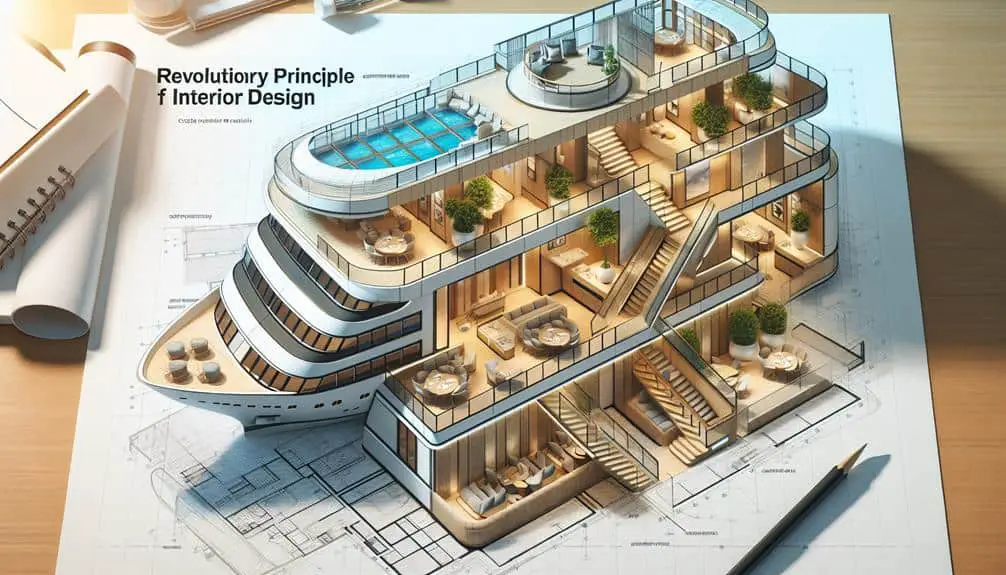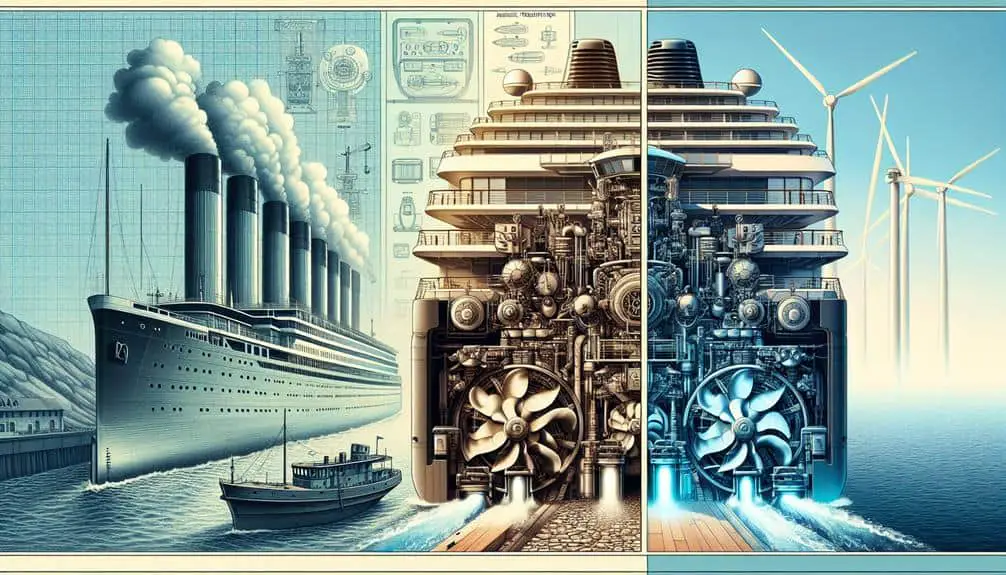On modern cruise ships, elevators have high capacity for swift movement. Wheelchair-friendly cabins feature wider doorways and roll-in showers. Spacious layouts and grab bars enhance safety. Accessible public areas include ramps, varied seating, and Braille signage. Assistive listening systems transmit audio wirelessly and offer portable devices. Clear communication links ship and port for easy access. If interested, more details on these features are available.
Key Points
- High elevator capacity (15 to 25 passengers) reduces wait times and congestion.
- Wheelchair-friendly cabins feature wider doorways and roll-in showers for accessibility.
- Public areas offer varied seating options and tactile signage for diverse needs.
- Assistive listening systems provide wireless audio transmission and portable devices for passengers.
- Cruise lines assist passengers with mobility challenges during tendering and offer accessibility for shore excursions.
Elevator Accessibility
When boarding a modern cruise ship, you'll find that elevator accessibility is an essential feature that guarantees smooth navigation throughout the vessel. Elevators on cruise ships are designed to accommodate a significant number of passengers efficiently. Elevator capacity is a critical factor, ensuring that guests can move between decks comfortably. Modern cruise ships are equipped with elevators that have a high capacity, typically ranging from 15 to 25 passengers per car. This ample capacity reduces wait times and congestion, enhancing the overall guest experience.
Moreover, elevator speed is another vital aspect of elevator accessibility on cruise ships. To ensure swift movement between decks, cruise ship elevators are designed for ideal speed. These elevators travel at a rate that enables quick transportation of passengers while maintaining safety standards. Elevator speed plays a pivotal role in facilitating the smooth flow of guests throughout the ship, allowing them to reach their desired destinations promptly. The combination of high elevator capacity and efficient speed contributes to a seamless and enjoyable cruising experience for all passengers.
Wheelchair-Friendly Cabins
On modern cruise ships, the accommodation extends to wheelchair-friendly cabins, ensuring accessibility and comfort for all passengers. These cabins are meticulously designed to cater to individuals with mobility challenges, offering a range of cabin amenities and cruise facilities tailored to meet their specific needs.
Wheelchair-friendly cabins are equipped with wider doorways to accommodate wheelchairs, as well as spacious layouts to allow for easy maneuverability within the cabin. These cabins feature lower bed heights, grab bars in the bathroom, and roll-in showers to enhance convenience and safety for passengers with mobility limitations.
In addition to these features, wheelchair-friendly cabins are strategically located near elevators for easier access to other decks and accessible public areas onboard. Cruise facilities such as dining venues, entertainment areas, and outdoor spaces are designed to be wheelchair-friendly, ensuring that passengers with mobility challenges can enjoy all aspects of the cruise experience without limitations.
Accessible Public Areas
Accessible public areas onboard modern cruise ships are meticulously designed to guarantee ease of navigation and comfort for all passengers. Pool access is facilitated through ramps with handrails or lifts, ensuring that individuals with mobility challenges can enjoy the pool facilities effortlessly. Seating options in these areas are varied, with benches, chairs, and loungers strategically placed to accommodate diverse needs.
Dining areas are equipped with navigation aids such as tactile paving and Braille signage to assist visually impaired passengers in finding their way around. Tables in restaurants and lounges are designed to accommodate wheelchairs comfortably, with ample space between them for easy maneuverability. Additionally, adjustable table heights cater to individuals with different requirements.
Assistive Listening Systems
Assistive Listening Systems on modern cruise ships incorporate advanced technology to enhance the auditory experience for passengers with hearing impairments. These systems utilize wireless technology to transmit audio signals directly to compatible hearing aids or headphones, ensuring clear sound quality without interference. Additionally, cruise ships often provide portable assistive listening devices for passengers who may not have compatible hearing aids.
In conjunction with Assistive Listening Systems, some cruise lines offer sign language interpreters for live performances, onboard announcements, and emergency situations. These interpreters play a significant role in ensuring effective communication for passengers who are deaf or hard of hearing. Moreover, Braille signage is strategically placed throughout the ship to assist passengers with visual impairments in finding their way in public areas, cabins, and facilities easily.
Tendering and Port Accessibility
Tendering procedures at ports are designed to facilitate the boarding and alighting of passengers from cruise ships efficiently. When it comes to ensuring accessibility during these processes, several key aspects need to be considered:
- Docking Procedures: Understanding how the ship docks at different ports can help you anticipate the boarding and alighting conditions.
- Passenger Assistance: Cruise lines typically provide assistance for passengers with mobility challenges during tendering procedures.
- Shore Excursions: Accessibility options for shore excursions vary, so it's important to inquire about the availability of accessible tours.
- Boarding Ramps: Some ports may use boarding ramps to facilitate the embarkation and disembarkation of passengers.
- Communication Systems: Clear communication systems between the ship and the port authorities are vital to ensuring smooth tendering operations.
Frequently Asked Questions
Are There Any Specific Accommodations for Guests With Visual Impairments on Modern Cruise Ships?
On modern cruise ships, specific accommodations for guests with visual impairments include Braille menus and tactile maps. These features enhance accessibility and guarantee all passengers can easily navigate and enjoy their cruise experience.
How Are Guests With Mobility Impairments Able to Access the Swimming Pools and Other Recreational Facilities on Board?
To access swimming pools and recreational facilities on modern cruise ships, guests with mobility impairments can utilize accessible pool lifts for pool entry and exit. Wheelchair access is guaranteed throughout the ship, including ramps and elevators.
Are There Any Designated Areas for Service Animals on Modern Cruise Ships?
When it comes to service animal policies on modern cruise ships, you'll find designated areas where your furry companions can relax comfortably. These pet-friendly options guarantee that both you and your service animal have a stress-free and enjoyable voyage.
What Types of Accommodations Are Available for Guests With Hearing Impairments During Onboard Entertainment and Activities?
For guests with hearing impairments on cruise ships, accommodations include sign language interpreters for entertainment and activities. Additionally, captioned performances are available to guarantee you have full access to onboard events and shows.
How Are Guests With Cognitive Disabilities Supported During Their Cruise Experience?
To support guests with cognitive disabilities on your cruise, sensory rooms and quiet spaces are available. These areas offer a calming environment to help you relax and enjoy your experience to the fullest.




